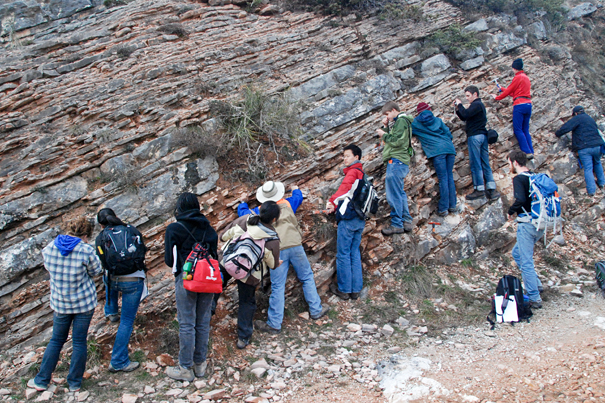
Students (below) line up along the boundary rock layer, which marks the mass extinction that killed the dinosaurs.
Photo by Ryan Petterson
The record in the rocks
Student field trip to Italy probes how life shifted on Earth
Before them was a sheer cliff made of whitish limestone. Tearing across the cliff was the Bonarelli, a stark black layer of rock over a meter thick, and highlighted below by flares of rusty orange. The question for these students was: How did this rock get here, and what can it tell us about Earth history?
History is written in stone. At least, it is for the geologist. One group of students in the Earth and Planetary Sciences Department journeyed to the Umbria-Marche region of Italy over spring break to study the most important book of their required reading. That book, of course, was the Earth itself, and the pages were layer upon layer of rock, each revealing part of the tale.
“This area is a really classic area for looking at Earth history,” said Associate Professor Francis Macdonald, a field geologist and the trip leader. The Umbria-Marche Appenines of Italy are world renowned for their geological outcrops. One of the best recorders of Earth history is marine sediment, which is preserved layer upon layer, era to era, on the ocean bottom. The Apennine Mountains are formed from these marine sediment layers, which have been thrust upward from the depths of the sea by plate tectonic motions. Clearly exposed in Italy, like almost nowhere else on the planet, is an account of history from about 220 million years ago to 2.6 million years ago.
Close to sunset, below a meandering ancient Roman aqueduct, Steven Jaret looked through his magnifying hand lens at an unremarkable bit of red clay. “Oh, wow! This is really cool. Look at that spherule: big, green, perfectly round,” exclaimed Jaret, a first-year graduate student, as he spotted vapor condensates that must have rained from the heavens shortly after an Earth-shattering asteroid impact. He had identified the thin layer in the rock record that divided two great eras. Below the clay layer, other students corroborated, it was evident the oceans were teaming with life. They could see the micro-organisms eternally fossilized in the rock. Above the clay, only the smallest and simplest life forms persisted. The rocks suggest the ocean underwent a catastrophic extinction event — one that correlates perfectly to the extinction of the dinosaurs. Few driving along this lonely road would suspect that it had been these rocks that spawned the asteroid impact hypothesis for the demise of the dinosaurs. About 30 years ago, this clay was discovered to have a spike in the rare earth element iridium. The iridium could only have come from an extraterrestrial source: an asteroid.
Students put their fingers on the thin clay layer that divides the eras, sampling the evidence that sparked one of the most fruitful geological discoveries of our time. Not only did it prove the asteroid impact, but also it catalyzed a paradigm shift in geological discourse: No longer was the Earth viewed simply as a gradually evolving system.
“It is very important to have students really appreciate how geologists think,” said Macdonald, who led the trip to Italy. “You have a problem, and you have to be able to figure out a way to use this data in the field to come up with a story. … Geology is really a question-driven science, and here there are just some really big questions exposed in the rocks.”
The presence of the Bonarelli is one of the mysteries that challenge modern geologists. Biogeochemistry Professor Ann Pearson joined the trip to survey the rock layer. The layer is composed of organic material that must have been deposited when there was no oxygen in the oceans. But why was there no oxygen in the oceans, and could that happen again? While Pearson collected samples to study the isotope signature of the material, students measured the distance between the various rock layers below the Bonarelli to determine if natural ocean cycles predict such a massive ocean event, or if this one was something truly extraordinary and perhaps cataclysmic.
Grappling with such problems may be advanced for beginners. But all the students agreed exposure to the “real questions” was far more illustrative than “book-learning.” Emily Howell, a freshman who challenged herself to participate in this upper-level course, said, “It’s definitely been tricky, but … I think that just going right out into the field is one of the best things because you actually get to see all these words that you keep hearing, and you get the big picture.”
The more experienced first-year graduate student, too, found the field experience indispensable. Jaret said, “You look at it in the fields and then you look at it in the textbook, and it’s like, ‘Oh, wow. That is not what it looks like in the textbook at all.’ It is really nice to actually see what geology is actually like.”
Before they left, the students did take time to experience the local culture. On the final day of the trip, after having been blessed with a week of good weather (and therefore productive fieldwork), students had an opportunity to roam the streets of the ancient city of Assisi, a fortified hilltop town famous for being the home of St. Francis.
The walls of the buildings and fortifications of the city were constructed from the very same stones that the students had been studying for a week. Well, most of the stones, at least. While savoring gelatos, a few students noticed that some of the construction materials weren’t local; these randomly placed pieces must have been carted in and integrated into the town’s architecture far more recently. The geologist observes his or her environment, and then make inferences about a place’s history. But perhaps more than just Earth history is written in stone.





